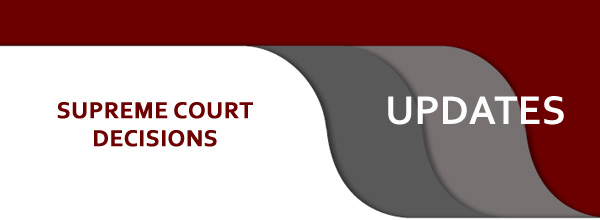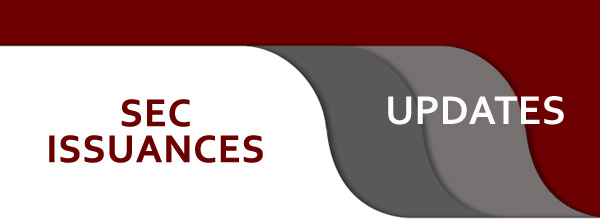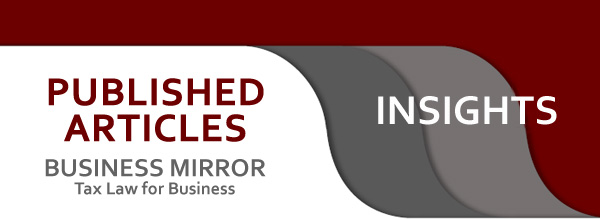

DECEMBER • VOL. 11 • SERIES OF 2023
INSIGHTS is a monthly publication of BDB LAW to inform, update and provide perspectives to our clients and readers on significant tax-related court decisions and regulatory issuances (includes BIR, SEC, BSP, and various government agencies).

DISCLAIMER: The contents of this Insights are summaries of selected issuances from various government agencies, Court decisions, and articles written by our experts. They are intended for guidance only and as such should not be regarded as a substitute for professional advice.
Copyright © 2023 by Du-Baladad and Associates (BDB Law). All rights reserved. No part of this issue covered by this copyright may be produced and/or used in any form or by any means – graphic, electronic, and mechanical without the written permission of the publisher.
What's Inside ...
- HIGHLIGHTS FOR NOVEMBER 2023
- SIGNIFICANT COURT DECISIONS
- Supreme Court
- Court of Tax Appeals
- SIGNIFICANT REGULATORY ISSUANCES
- Bureau of Internal Revenue
- Bangko Sentral ng Pilipinas
- Securities and Exchange Commission
- PUBLISHED ARTICLE
- PILLAR TWO: Where Are We Now?
- OUR EXPERTS
- The Personalities
- The Personalities


HIGHLIGHTS for NOVEMBER 2023
SUPREME COURT DECISIONS
-
The propriety of seizure and detention of excisable items falls under the purview of “other matters arising under the National Internal Revenue Code or other laws administered by the BIR” which is within the exclusive appellate jurisdiction of the CTA in Section 7(a)(1) of RA No. 1125, as amended. (Oceangold (Philippines), Inc. v. Commissioner of Internal Revenue. G.R. No. 234614, June 14, 2023)
COURT OF TAX APPEALS DECISIONS
-
The electric cooperatives registered with NEA are subject to income tax on certain sources. However, since taxpayer relied upon a previous ruling stating otherwise, the assessment imposing income tax against it is void. (Nueva Ecija I Electric Cooperative, Inc. v. Commissioner of Internal Revenue, et. al., CTA Case Nos. 10587 & 10632, November 13, 2023)
-
To assail a real property tax assessment, the taxpayer must comply with the procedures under Section 252 of the LGC which requires it to pay taxes “under protest” and file a protest letter; otherwise, the assessment will become final and executory. (Mactan Electric Company, Inc. v. The Municipality of Cordova, et. al, CTA AC No. 258, November 17, 2023)
-
Tax Billing without facts and laws on which the billed Local Business Tax amount is based is not considered as a tax assessment. (Holcim Philippines, Inc. v. The City of Taguig, et. al., CTA AC No. 268, November 15, 2023)
-
An unprotested final tax assessment would only attain finality if the assessment were valid. (Commissioner of Internal Revenue v. Digos Market Vendors Multi-Purpose Cooperative (DIMAVEMC), CTA EB No. 2518, November 30, 2023)
-
When the taxpayer denies receipt of the assessment notices, it became incumbent upon the CIR to prove by competent evidence that the assessment notices were indeed mailed to and received by the taxpayer. (Commissioner of Internal Revenue v. 10K South Concrete Mix Specialist, Inc., CTA EB No. 2647 [CTA Case No. 9730], November 24, 2023)
BIR ISSUANCES
- RR No. 13-2023, November 10, 2023 – This pertains to rules and regulations prescribing policies and guidelines for the Optional VAT-Registration of Registered Business Enterprises Classified as Domestic Market Enterprise under Five Percent (5%) Tax on Gross Income Earned in lieu of all taxes regime during the transitory period pursuant to Rule 18, Section 5 of Amended Implementing Rules and Regulations of RA No. 11534 of CREATE Act.
- RR No. 14-2023, November 10, 2023 – This amends pertinent provisions of RR No. 2-98, as amended, to impose creditable withholding tax on certain income payments by Joint Ventures/Consortiums.
- RMC No. 120-2023, November 9, 2023 – This circularizes the availability, use and acceptance of Digital TIN ID.
- RMC No. 121-2023, November 29, 2023 – This is issued to announce the availability and implementation of the additional features and functionalities of the Online Registration Update System (ORUS) starting November 21, 2023.
BSP ISSUANCES
- BSP Circular No. 1180, November 10, 2023 – This provides amendments to the Check Clearing and Settlement Regulations.
SEC ISSUANCES
- SEC Memorandum Circular No. 20, November 3, 2023 – This provides final extension of amnesty applications until December 31, 2023.
- SEC Memorandum Circular No. 21, November 14, 2023 – The provides amendments to SEC Memorandum Circular No. 2, Series of 2014 – Guidelines on Asset Valuations.


The propriety of seizure and detention of excisable items falls under the purview of “other matters arising under the National Internal Revenue Code or other laws administered by the BIR” which is within the exclusive appellate jurisdiction of the CTA in Section 7(a)(1) of RA No. 1125, as amended.
The taxpayer filed a request for ruling before the Commissioner of Internal Revenue (CIR) to confirm its tax exemption for excise taxes on minerals during the recovery period. In response, the Bureau of Internal Revenue (BIR) issued BIR Ruling No. 10-2007 confirming the taxpayer’s tax exemption in accordance with the terms of the agreement that the latter executed, the Philippine Mining Act of 1995, and its Implementing Rules and Regulations. However, the same ruling was invalidated by Revenue Memorandum Circular (RMC) No. 17-2013. The BIR also seized and detained the taxpayer’s copper concentrates for the latter’s alleged failure to pay excise taxes. The taxpayer then paid the same under protest.
However, despite payment, the BIR again seized and detained metric tons of copper concentrates. Thus, the taxpayer filed before the CTA a Petition for Review assailing the (1) seizure and detention of its copper concentrates; (2) the alleged illegal collection of excise taxes; and (3) the validity of RMC No. 17-2013. The taxpayer’s Petition was denied by the Court of Tax Appeals (CTA) for lack of jurisdiction. It ruled that the validity and constitutionality of rules and regulations lies with the regular courts and not the CTA. It also declared that it could not rule on the validity of the BIR's apprehension and detention of taxpayer’s copper concentrates since this would depend on the validity or invalidity of the assailed RMC.
The Supreme Court partially granted the taxpayer’s Petition. On the issue of the validity of the assailed RMC, it ruled that the CTA En Banc correctly held that this should have been first elevated to the Secretary of Finance. However, the CTA En Banc erred in throwing out the taxpayer’s “lock, stock, and barrel” just for this reason. Contrary to its conclusions, the seizure, apprehension, and detention of the taxpayer’s copper concentrates are not hinged on RMC No. 7-2013.
Notably, some apprehension and seizure occurred before the issuance of the assailed RMC, hence, this should be appreciated as a separate matter from the issue on the validity of the said RMC. The same should be interpreted in relation to Sections 171 and 172 of the Tax Code which falls under the purview of “other matters arising under the National Internal Revenue Code or other laws administered by the BIR” which is within the exclusive appellate jurisdiction of the CTA in Section 7(a)(1) of RA No. 1125, as amended, rather than to be considered some form of assessment or penalty per se. Nevertheless, it is only the decision of the CIR, or his duly authorized representative, on such matters which is appealable to the CTA, and certainly not the act of the revenue officers in the first instance. Thus, strictly speaking, the taxpayer should have first filed a protest for the seizure and detention of its copper concentrates prior to seeking judicial relief before the CTA. Despite the foregoing, there is sufficient reason to relax the rule on exhaustion of administrative remedies, such as when there is a violation of due process or when there is estoppel on the part of the administrative agency concerned, or when there are circumstances indicating the urgency of judicial intervention which are present in this case. (Oceangold (Philippines), Inc. v. Commissioner of Internal Revenue. G.R. No. 234614, June 14, 2023)


The electric cooperatives registered with NEA are subject to income tax on certain sources. However, since taxpayer relied upon a previous ruling stating otherwise, the assessment imposing income tax against it is void.
The taxpayer contends that the income tax assessments against it for taxable years (TY) 2012 and 2013 are void because as an electric cooperative registered with the National Electrification Administration (NEA), it enjoys permanent income tax exemption under Section 39(a)(1) of PD No. 269.
The Court ruled that the electric cooperatives registered with NEA are subject to income tax on certain sources. It clarified that the supposed permanent income tax exemption of electric cooperatives under Section 39(a)(1) of PD No. 269, as amended which has been effectively withdrawn by subsequent legislation, was not entirely restored by FIRB Resolution No. 24-87. At present, electric cooperatives registered with NEA are subject to income tax with respect to income tax derived from: (1) electric service operations; and (2) other sources such as interest income from bank deposits and yield or any other monetary benefit from bank deposits and yield or any other similar arrangements.
In this case, however, although the taxpayer is subject to income tax, the assessment for TY 2012 is void for being violative of Section 246 of the Tax Code, which provides that taxpayers may rely upon a rule or ruling issued by the Commissioner of Internal Revenue (CIR) or the Court. The reversal of which is not given a retroactive effect. Here, the assessment was based on RMC No. 74-2013 which clarified that electric cooperatives registered with the NEA are subject to income tax in accordance with FIRB Resolution No. 24-87. However, prior to such issuance, the CIR issued RMC No. 72-2003 which provides that the electric cooperatives registered with NEA are exempt from income taxes for which they are directly liable. Thus, from the promulgation of RMC No. 72-2003 on October 20, 2003, up until November 25, 2013, or prior to the issuance of RMC No. 74-2013, it was the CIR’s position that electric cooperatives registered with NEA are exempt from income tax, notwithstanding that FIRB Resolution No. 24-87 has been effective since July 14, 1987.
On the other hand, the assessment for TY 2013 is also void since the revenue officers who conducted the audit were not clothed with proper authority. (Nueva Ecija I Electric Cooperative, Inc. v. Commissioner of Internal Revenue, et. al., CTA Case Nos. 10587 & 10632, November 13, 2023)
A taxpayer cannot assail the CTA’s jurisdiction over a case between a GOCC and a government agency after it files the same and later receives a decision from the CTA denying its claim.
This case involves a refund claim of a GOCC. It argues that the CTA has no jurisdiction over this claim for refund as disputes involving a GOCC and a government agency is with the Department of Justice (DOJ).
The CTA En Banc ruled that the CTA has jurisdiction over the case. It highlighted the Supreme Court’s ruling that “a party cannot invoke jurisdiction at one time and reject it at another time in the same controversy to suit its interest and convenience. Jurisdiction is conferred by law and cannot be made dependent on the whims and caprices of a party. Jurisdiction, once acquired, continues until the case is finally terminated.”
Here, the taxpayer filed a Petition for Review before the CTA in Division seeking the refund of its erroneously paid VAT. After the Court’s denial of its claim, it is now claiming that the Court in Division has no jurisdiction over the same.
It lodged the case before the CTA, aware of and, in fact, invoking the Court’s jurisdiction over its claim for refund, hence, having acquired jurisdiction over the dispute, the Court in Division continues to exercise the same until the termination of the case. (National Development Company v. Commissioner of Internal Revenue, CTA EB No. 2572 [CTA Case No. 9633], November 13, 2023)
To assail a real property tax assessment, the taxpayer must comply with the procedures under Section 252 of the LGC which requires it to pay taxes “under protest” and file a protest letter; otherwise, the assessment will become final and executory.
The taxpayer received a Notice of Assessment dated June 12, 2008, with the subject Tax Declarations from the Municipality of Cordova. Subsequently, on October 13, 2011, it received a letter of even date from the Provincial Treasurer of Cebu in relation to its supposed unpaid taxes from 1992 to 2011, with computations of real property tax from the Municipality of Cordova for its transformers. It also received two other letters dated March 14, 2012, and March 27, 2012 from the Provincial Treasurer, inviting it to meetings with the Governor of Cebu to discuss the real property tax delinquency. On April 30, 2012, the taxpayer filed a complaint with the RTC seeking the (a) issuance of a Writ of Preliminary Injunction, (b) the nullification of the Notice Assessment and the subject Tax Declarations, and (c) the issuance of final injunction. The Municipality of Cordova and Provincial Treasurer contend that the taxpayer failed to file an appeal to the Local Board of assessment Appeals (LBAA), hence, its Petition should be denied.
The Court ruled against the taxpayer. It held that the taxpayer failed to comply with the requirement of payment under protest in Section 252, in relation to Sections 226 and 229 of the Local Government Code (LGC). Under this Section, it is required that the taxpayer must first pay the tax under protest and file a protest with the Local Treasurer within 30 days from the date of payment of the tax. If the protest is denied or upon the lapse of 60-day period for the Local Treasurer to decide on the protest, the taxpayer may appeal to the LBAA within 60 days from the denial of the protest or the lapse of the 60-day period to decide. Then, if the taxpayer is unsatisfied with the decision of the Local Board of Assessment Appeals (LBAA), it may appeal before the Central Board of Assessment Appeals (CBAA) within 30 days from receipt of the LBAA’s decision. The decision of the CBAA is appealable before the CTA En Banc.
In this case, the taxpayer, after receiving notices and letter from the Municipality of Cordova and Provincial Treasurer, did not pay “under protest” the assessed real property taxes and filed a protest under Section 252 of the LGC. For its failure to do so, the subject assessment becomes final and executory. (Mactan Electric Company, Inc. v. The Municipality of Cordova, et. al, CTA AC No. 258, November 17, 2023)
Tax Billing without facts and laws on which the billed Local Business Tax amount is based is not considered as a tax assessment.
The City of Taguig issued four Billing Statements assessing the taxpayer of local business tax (LBT) for four quarters of taxable year 2018. The taxpayer paid the said LBT. On later dates, it filed claims for refund of its alleged overpayment of LBT before the City Treasurer. The taxpayer maintains that the bases of the assessment for LBT for taxable year 2018 were erroneous and contrary to law.
The City Treasurer failed to act on the taxpayer’s claims for refund prompting the latter to elevate its claim before the RTC which denied the same. In dismissing the case for refund of LBT, the RTC ruled that while the tax base used by the City of Taguig were indeed erroneous, the taxpayer filed its judicial claim beyond the 30-day period. The Billing Statements issued by the City of Taguig were in the Nature of Assessment. Considering that the City Treasurer did not act on the taxpayer’s claims, the taxpayer should have filed its appeal within 30 days from the lapse of the 60-day period for it to decide on the same under Section 195 of the LGC.
The Court reversed the RTC’s decision. It ruled that the subject Billing Statements are not “assessments” contemplated under Section 195 of the LGC applying the Supreme Court’s decision in the case of National Power Corporation v. The Province of Pampanga, et. al (G.R. No. 230648, October 6, 2021). In the said case, the Supreme Court stressed that the notice of assessment should provide the facts and laws on which the assessment was based, among others.
In this case, a perusal of the Billing Statements shows that the same did not provide notice of the facts and laws on which the billed amounts were based. In fact, it is not assessment of LBT but merely for the renewal of the taxpayer’s business permit. Hence, since no assessment notice was issued and the taxpayer claims that it erroneously paid a tax, Section 196 of LGC applies which requires that the refund claim shall be filed with the local treasurer and with the Court within 2 years from the date of payment of such tax. Here, the taxpayer has complied with the said requirements (Holcim Philippines, Inc. v. The City of Taguig, et. al., CTA AC No. 268, November 15, 2023)
An unprotested final tax assessment would only attain finality if the assessment were valid.
The taxpayer was assessed for all internal revenue taxes for taxable year 2006. It assailed the assessment before the CTA in Division which ruled in favor of the taxpayer declaring the assessment null and void. The CIR appealed the said decision before the CTA En Banc, arguing that the Court in Division has no jurisdiction to try and hear the case, considering that the deficiency tax assessments against the taxpayer have become final, executory, and demandable for its failure to file its protest to the PAN and FLD.
The CTA En Banc affirmed CTA in Division’s decision. It emphasized that the CIR’s contention that the deficiency tax assessments have already become final, executory and demandable should be premised on the assessment’s validity. Here, as found by CTA in Division, the BIR failed to comply with the due process requirements in issuing the subject assessments rendering the said assessment void.
Under Section 228 of the Tax Code, the taxpayer must be given 15 days to respond to the PAN as part of the due process requirement. It necessarily follows that only after the BIR's receipt of the taxpayer response or in the case of the taxpayer’s default can it issue the FLD/FAN. In this case, PAN and FLD was issued only one day apart from each other. Clearly ignoring the taxpayer’s right to respond to the PAN. Consequently, the assessments are void. (Commissioner of Internal Revenue v. Digos Market Vendors Multi-Purpose Cooperative (DIMAVEMC), CTA EB No. 2518, November 30, 2023)
A proprietary educational institution is not exempted from paying LBT.
The LGU of Makati issued notice of assessments (NOA) against the taxpayer, an educational institution for LBT. The taxpayer argues that the Makati LGU has no authority under the LGC to impose business taxes on educational institutions such as itself, and on the tuition fees and school fees it collects.
The CTA En Banc ruled that the taxpayer, a proprietary educational institution is not exempted from paying LBT. The Court notes that Article XIV, Section 4, Par. 3 of the 1987 Philippine Constitution explicitly exempts all revenues and assets of non-stock, non-profit educational institutions from taxes provided that they are actually, directly, and exclusively used for educational purposes. However, in this case, the taxpayer is a stock corporation or a proprietary entity. Hence, it is not covered by the said provision. (Malayan Education System, Inc. v. City of Makati, City Mayor and City Treasurer, CTA EB Nos. 2546, 2558 [CTA AC No. 225], November 20, 2023)
When the taxpayer denies receipt of the assessment notices, it became incumbent upon the CIR to prove by competent evidence that the assessment notices were indeed mailed to and received by the taxpayer.
The taxpayer was assessed for all internal revenue taxes for taxable year 2013. In assailing the assessment, it argued that it did not receive the FAN and ANs issued by the BIR. While the CIR contends that the FAN and ANs were mailed to the taxpayer’s registered address as evidenced by the Record of Case of the Administrative Division of the BIR RR No. 8 and the Certification from the Postmaster of Parañaque Central Post Office. Based on the record, the FAN and ANs were received by the taxpayer’s representative. The Court En Banc denied the CIR’s contentions. It ruled that the CIR failed to discharge the burden of proof that the subject FAN and ANs were mailed to and received by the taxpayer. It reiterates the well-settled rule that when the taxpayer denies receipt of the assessment notices, it became incumbent upon the CIR to prove by competent evidence that the assessment notices were indeed mailed to and received by the taxpayer.
Here, the Record Certification and Postmaster Certification merely indicate that a certain document was mailed. However, these documents failed to provide confirmation that the items mailed to the taxpayer were the subject FAN and ANs. (Commissioner of Internal Revenue v. 10K South Concrete Mix Specialist, Inc., CTA EB No. 2647 [CTA Case No. 9730], November 24, 2023)

RR No. 13-2023, November 10, 2023
This pertains to rules and regulations prescribing policies and guidelines for the Optional VAT-Registration of Registered Business Enterprises Classified as Domestic Market Enterprise under Five Percent (5%) Tax on Gross Income Earned in lieu of all taxes regime during the transitory period pursuant to Rule 18, Section 5 of Amended Implementing Rules and Regulations of RA No. 11534 of CREATE Act.
This pertains to rules and regulations prescribing policies and guidelines for the Optional VAT-Registration of Registered Business Enterprises Classified as Domestic Market Enterprise under Five Percent (5%) Tax on Gross Income Earned in lieu of all taxes regime during the transitory period pursuant to Rule 18, Section 5 of Amended Implementing Rules and Regulations of RA No. 11534 of CREATE Act.
|
NON-INCOME RELATED TAX INCENTIVES o All registered export and domestic enterprises that will continue to avail • Duty exemption o All registered export enterprises as defined under Section 293(E) of the o A registered business enterprise (RBE) classified as domestic market o Provided that such exemptions shall only apply to goods and services OPTIONAL VAT-REGISTRATION o An RBE classified as DME which is located inside the economic or o The waiver of rights to avail of the VAT exemption incentive shall be
|
RR No. 14-2023, November 10, 2023
This amends pertinent provisions of RR No. 2-98, as amended, to impose creditable withholding tax on certain income payments by Joint Ventures/Consortiums.
The following are the amendments to Section 2.57.2 of RR No. 2-98:
“(V) Income payments made by joint ventures/consortiums. – Income payments made by joint ventures, whether incorporated or not, taxable or not, taxable or non-taxable, to their local/resident supplier of goods and services, shall be subjected to the following withholding tax rates:
Supplier of goods – One percent (1%)
Supplier of services – Two percent (2%)
(W) Distributive share of co-ventures/members from the net income of the joint venture/consortium not taxable as corporation. – On the share of each co-venturer/member from the net income of the joint venture/consortium not taxable as corporation prior to actual or constructive distribution thereof – Fifteen percent (15%).
RMC No. 120-2023, November 9, 2023
This circularizes the availability, use and acceptance of Digital TIN ID.
RMO No. 121-2023, November 29, 2023
This is issued to announce the availability and implementation of the additional features and functionalities of the Online Registration Update System (ORUS) starting November 21, 2023.
The following additional features and functionalities of ORUS are now available online:


BSP Circular No. 1180, November 10, 2023
This provides amendments to the Check Clearing and Settlement Regulations.
The Monetary Board (MB) approved the following amendments to check clearing and settlement regulations in the Manual of Regulations for Banks (MORB):
202 RETURNED CHECKS
xxx
c. The Drawee bank shall transmit the electronic documents relative to the dishonor to the Presenting bank within the prescribed period or not later than the cut-off time indicated in Appendix 35 for returned items in accordance with the following procedures:
xxx
(2) the AM clearing window for clearing items dishonored due to insufficiency of funds or credit, technical reason, closed account, and/or stop payment order shall be conducted in accordance with the timeline prescribed in Appendix 35 for returned items; and
(3) The returned checks shall be settled through the Peso Real-Time Gross Settlement (RTGS) system. For purposes of settlement, the value date of the returned Checks and Other Cash Items (COCIs) in the AM clearing window shall be the date of settlement through the Peso RTGS system.
285 EMERGENCY LOANS OR ADVANCES TO BANKING INSTITUTIONS
xxx
Acceptable collaterals and their corresponding loan values. xxx
|
ACCEPTABLE COLLATERAL |
With Surety Agreement and Negative Pledge | With Surety Agreement but No Negative Pledge | With Negative Pledge but No Surety Agreement | No Surety Agreement and No Negative Pledge |
| XXX | XXX | XXX | XXX | XXX |
| Assets of other third parties to cover deficiency arising from unpaid interest and liquidated damages and reduction in loan value of existing collaterals: | ||||
| XXX | XXX | XXX | XXX | XXX |
xxx
Interest rates, liquidated damages, and penalties. xxx
xxx
Any shortfall in collateral due to unpaid accrued interest, liquidated damages, and reduction in loan value of existing collaterals may be covered by third-party assets after the assets of the bank have been exhausted.
802 CHECK CLEARING OPERATIONS
A check clearing switch operator (check CSO) is appointed and designated by the Bangko Sentral as a processing agency and exclusive provider of a nationwide Automated Clearing Facility. It shall implement clearing of checks via electronic presentment through its Check Image and Clearing System (CICS) upon receipt by the Bangko Sentral of written notice from the check CSO that CICS is operational.
Banks shall observe the clearing procedures in accordance with the check CSO rules for the clearing of checks, including the Banks’ responsibility to verify the accuracy of reports and directly communicate with the concerned party regarding any clearing discrepancy or error noted in the course of proving their incoming/outgoing clearing items.
Appendix 25 is deleted
Appendix 35 shall now be titled as “Schedule of Peso Real Time Gross Settlements”
Appendix 123 is also amended.


SEC Memorandum Circular No. 20, November 3, 2023
This provides final extension of amnesty applications until December 31, 2023.
SEC Memorandum Circular No. 21, November 14, 2023
This provides amendments to SEC Memorandum Circular No. 2, Series of 2014 – Guidelines on Asset Valuations.


PILLAR TWO: Where Are We Now?
By Atty. Jomel N. Manaig
A little more than a year ago in my article “OECD’s Pillar Two and the Tax Incentives in the Philippines,” we took a peek at what Pillar Two, or the global minimum corporate tax, is all about and how it can affect domestic subsidiaries of multinational entities.
From then on, we have made some progress in amending our tax laws. For better or for worse, none of these even comes close to touching Pillar Two. However, all that may soon change.
Last October 2023, it was announced that the Philippines joined the OECD/G20 Inclusive Framework on Base Erosion and Profit Shifting (BEPS). It means that the country will be participating in the implementation of the BEPS measures which include Pillar Two.
Actual implementation by the Philippines of Pillar Two may be for a while if we will consider the pace of our recent tax law amendments as a yardstick. Nonetheless, due to the extraterritorial nature of Pillar Two, domestic corporations with parents in foreign countries may already be affected by Pillar Two notwithstanding the lack of actual implementation by our very own tax authorities.
Among our biggest foreign investors, Japan, Singapore, and the United Kingdom already have various implementation dates for Pillar Two. On the other hand, other ASEAN members like Indonesia, Malaysia, and Thailand have also joined the bandwagon and have made announcements on their respective plans and dates of implementation of Pillar Two.
With several countries already eyeing the implementation of Pillar Two by 2024, are our domestic corporations ready? What are some of the practical concerns that must be considered?
For one, corporations must thoroughly familiarize themselves with Pillar Two and its components. This is because Pillar Two is not as simple as imposing the global minimum corporate tax of 15%. Far from it. Pillar Two is actually composed of several independent model rules that work together to effectively impose the global minimum corporate tax.
These rules include the “Income Inclusion Rule” wherein the global minimum corporate tax is paid at the level of the parent entity in proportion to its ownership interests in those entities that have low taxed income. Another rule is the “Undertaxed Payments Rule” wherein a taxpayer who is a member of a multinational group is allowed to make an adjustment in respect of any top-up tax that is allocated to that taxpayer from a low-tax constituent entity of the same group. Lastly, the Qualified Domestic Minimum Top-up Tax Rule allows for the imposition of a domestic minimum tax that applies to local constituent entities of covered multinational entities and produces outcomes that are consistent with the Global Anti-Base Erosion rules.
That is a lot to take in, I know. And that is why domestic entities must start educating their officers and personnel. Pillar Two is a complicated subject and it cannot be taught and understood overnight.
Another practical concern that domestic corporations must face is the actual computation of the jurisdictional excess profit. If a domestic corporation has a foreign parent that is subject to Pillar Two, that foreign entity would most likely require the domestic corporation to compute its jurisdictional excess profit. The foreign parent would then use this data to compute for any top-up tax.
While the computation may be subject to a threshold for error, accuracy is still a paramount consideration. How can one be accurate in computing the jurisdictional excess profit if he/she does not know how to compute it in the first place?
Domestic corporations should start thinking about their plans to cope with Pillar Two requirements. Whether they consult their foreign parents for guidance or start planning on their own, the time to act is now
----------------------------------------------
For inquiries on the article, you may call or email
ATTY. JOMEL N. MANAIG
Junior Partner
T: +63 2 8403-2001 local 380
jomel.manaig@bdblaw.com.ph



DISCLAIMER: The contents of this Insights are summaries of selected issuances from various government agencies, Court decisions and articles written by our experts. They are intended for guidance only and as such should not be regarded as a substitute for professional advice.
Copyright © 2023 by Du-Baladad and Associates (BDB Law). All rights reserved. No part of this issue covered by this copyright may be produced and/or used in any form or by any means – graphic, electronic and mechanical without the written permission of the publisher.






